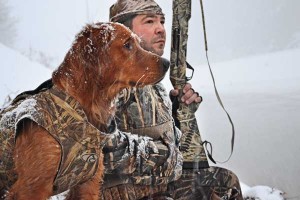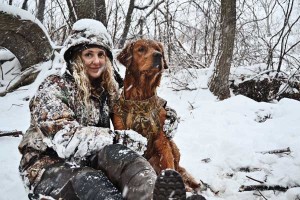January 08, 2014
By Kyle Wintersteen
 Recently, I heard a well-known outdoors writer remark, "If it isn't too cold to hunt, it isn't too cold for my Labs."
Recently, I heard a well-known outdoors writer remark, "If it isn't too cold to hunt, it isn't too cold for my Labs."
To an extent, this is true. Labs and especially Chesapeakes have a very dense, oily undercoat that provides a layer of protection from cold and moisture. Shorthairs, most spaniel breeds, and other non-conventional duck dogs lack this undercoat — I love my springers, but don't allow them prolonged exposure to water below 40 degrees.
However, no dog is immune to discomfort or even hypothermia when exposed to extremely cold water.
"As a rule of thumb, if you need hand warmers to stay adequately warm, you need to be aware of your retriever's comfort," says Dr. Michael Moss, an avid waterfowler and owner of the University Drive Veterinary Hospital in State College, Penn.
Advertisement
It starts with a properly fitted neoprene vest, which helps dogs conserve body heat as well as keeping out cold air and water, says Moss. Just make sure it's not too tight.
Heat loss is primarily a result of exposure to the near-freezing water. Therefore it's common practice among many to refrain from bathing dogs mid-season to preserve water-resistant oils (much as spouses may protest). And I always keep a few towels on hand. The faster you can dry your dog — especially if he's a non-undercoat breed — the better off he'll be. Of course, sometimes water turns to ice faster than you can dry it.
"Some hunters keep propane heaters in the blind," says Moss. "They melt the accumulated ice and keep everyone more comfortable."
Advertisement
Moss also recommends exposing your dog to the cold prior to the season so it's conditioned to the elements. Imagine the shock to your system if you vacationed in Aruba the week prior to a late-season duck hunt. This is of particular concern for Labs that double as house pets — make sure they spend some time outside.
In addition to these precautions, stay alert for any signs your dog has become too cold to continue hunting. Initial signs of hypothermia in humans include the "umbles": uncontrollable shivering accompanied by mumbling, stumbling and fumbling. Dogs become similarly confused and disoriented.
 "Watch your dog for extreme shivering that continues even if he's distracted," says Moss. "Or he may not respond to commands with his usual enthusiasm. I've also seen dogs try to curl up in the blind or boat bottom to help warm themselves. These are all signs your dog may be suffering."
"Watch your dog for extreme shivering that continues even if he's distracted," says Moss. "Or he may not respond to commands with his usual enthusiasm. I've also seen dogs try to curl up in the blind or boat bottom to help warm themselves. These are all signs your dog may be suffering."
If you suspect any of these symptoms, it's time to get your dog to a warm, dry environment. It's not an immediate emergency, but it can't be allowed to progress.
Fortunately with these precautions and a watchful eye, your dog is prepared for most any conditions.
"I recall hunting divers in Canada one January with my Lab, Vinny," Moss says. "For hours, he watched intently for birds while sitting on the aluminum boat deck with a wet coat in sub-zero weather. When he finally had a duck to retrieve, he left clumps of hair frozen to the boat."

